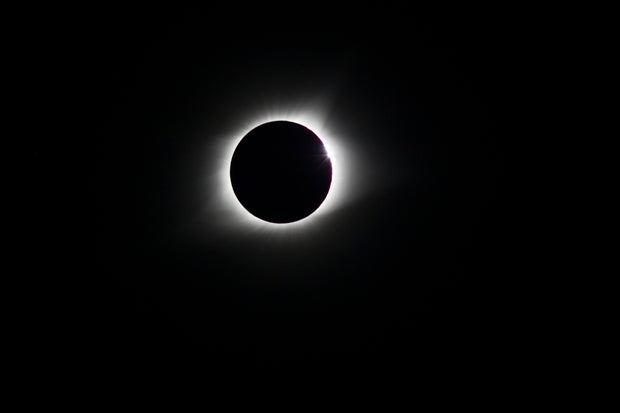▶ Watch Video: Solar eclipse expected to boost local economies as travelers pay a premium
Eclipse-watchers have been waiting more than six years since the last time a total solar eclipse charted its way across the United States, in 2017. After the rare event arrives on April 8, be aware — the next chance won’t be coming around any time soon.
Viewers in what’s called “the path of totality” will see the moon completely block the sun — an opportunity those in North America won’t have again for 20-plus years. The next total solar eclipses in North America are not anticipated until 2044 and 2045.
“A total solar eclipse is one of the most spectacular things anyone can see in their lifetime,” Virginia Tech astrophysicist Nahum Arav told CBS News. The eclipse “looks like a black hole in the sky,” said Arav, who watched the paths of totality of eclipses in 1991 and 2017.

Today’s eclipse will start to appear mid-morning around 11:07 a.m. PDT on the Pacific Coast of Mexico, then move into Texas. The eclipse’s visibility is predicted to track through 15 states — Oklahoma, Illinois, Ohio, Pennsylvania, New York, Vermont, New Hampshire and Maine, among them — before heading northward into Canada and then exiting North America.
If the weather is clear, millions of people from coast to coast will be able to see a partial solar eclipse, in which the moon partially covers the sun. However, only those within the path of totality and will experience the darkness of the total solar eclipse.
When is the next total solar eclipse in the U.S. after the 2024 eclipse?
Solar eclipses happen about twice a year, said Arav. “Eclipses happen all over the Earth evenly,” he told CBS News — but noted the timings when they occur are not regular. That means eclipses can occur within just a few years, or every few decades, in North America.
Before the eclipse in 2017, the last total solar eclipse to cross North America was in 1979. That was the first eclipse whose path of totality crossed the entire continent in 99 years.
Even though eclipses may seem to occur randomly, scientists can pinpoint exactly when and where they will happen.
“There is no ambiguity, as we know exactly where it will land,” said Arav.
There will be eight total solar eclipses visible from North America in the 21st century, Arav said, with one occurring about every 12 years, on average.
The next total solar eclipse to cross North America is predicted to occur on Aug. 23, 2044, NASA said. However, the path of totality from this eclipse will only touch three states, according to The Planetary Society, a nonprofit organization dedicated to public interest in space.
This next eclipse will mainly be observed in Canada, Arav said.
Path of totality for the 2044 total solar eclipse
The 2044 eclipse will start in Greenland on Aug. 23, 2044, and will continue its path through Canada.
The 2044 total solar eclipse will be short, mostly appearing in Canada. It will be visible from three states in the U.S.: Montana, Nroth Dakota and South Dakota.
The path of totality will cross Williston and Dickinson, North Dakota, and Great Falls, Montana.
Path of totality for the 2045 total solar eclipse
The next solar eclipse that crosses a significant portion of the continental U.S. will be in 2045, said Arav. That year, a solar eclipse will darken skies in parts of the U.S., Haiti, Dominican Republic, Venezuela, Guyana, French Guiana, Suriname and Brazil.
In North America, the 2045 total eclipse will be visible in many states as it moves from coast to coast. The eclipse will start in California and move east to end in Florida, similar to 2017, Arav said.
There will be numerous U.S. cities where eclipse watchers can view the total eclipse, including Reno, Nevada; Colorado Springs, Colorado; and Orlando, Florida.
Future solar eclipses in North America after 2045
Scientists have predicted eight total solar eclipses will appear in North America in the 21st century.
“Natural phenomena are like a Swiss clock,” Arav said. We know exactly when and where they will appear.”
After the 2044 and 2045 total solar eclipses, the next total eclipses in North America will occur in 2078 and 2099.
May 11, 2078
This total solar eclipse on May 11, 2078, will pass over the southern United States.
Cities include:
Atlanta, Georgia
New Orleans, Louisiana
Charlotte, North Carolina
Virginia Beach, Virginia
Sept. 14, 2099
This total solar eclipse on Sept. 14, 2099, will cross a wide swath of the United States.
Cities include:
Minneapolis, Minnesota
Milwaukee, Wisconsin
Chicago, Illinois
Columbus, Ohio
Fargo, North Dakota







